Chinese Algae Eater (Gyrinocheilus aymonieri) commonly known as the Golden Algae Eater – is freshwater fish that will help its tank owner deal with algae. This is what we know from the theory. However, things are a bit different in real life. After being a tireless tank cleaner in its youth, an adult species changes its gustatory preferences and starts to fancy live food as well as it can even start to nip its tank mates scales.
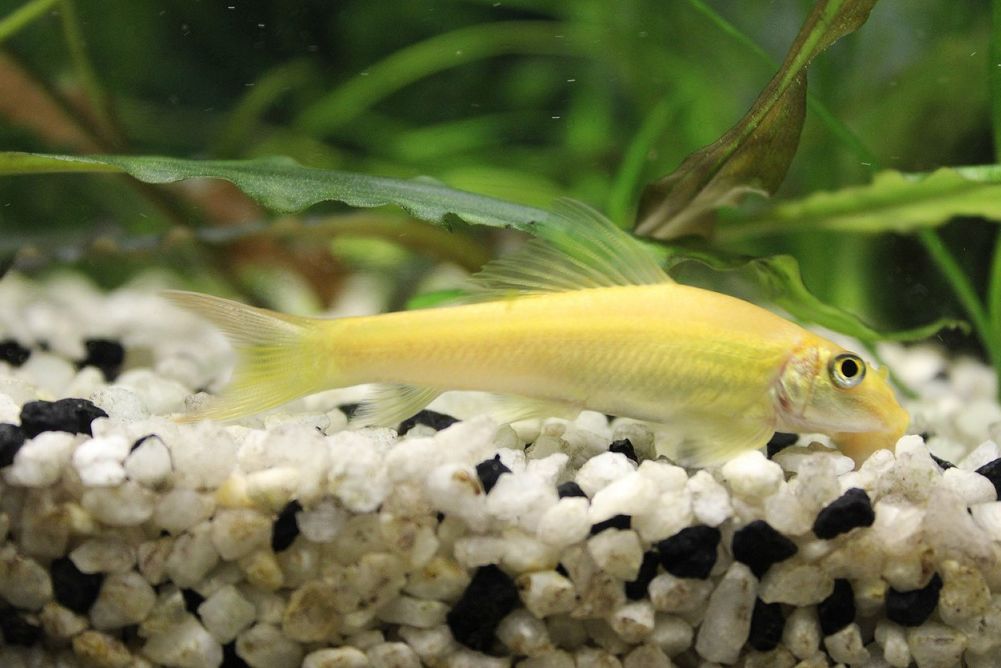
Contents
Habitat in the wild
Gyrinocheilus aymonieri belongs to the family Gyrinocheilidae, commonly known as the Chinese algae eater family or the sucking loach family. This family is a small group of freshwater fish that are native to Southeast Asia. The Gyrinocheilidae family consists of only three recognized species: Gyrinocheilus aymonieri (Chinese algae eater), Gyrinocheilus pennocki and Gyrinocheilus pustulosus.
The chinese algae eater latin name originated from two words: Greek Gyrinocheilus, gyrinos = «a tadpole» + cheilos = «a lip» due to it’s a bit triangle-shaped, similar to a tadpole mouth shape. And Aymonieri: in memory of a Franch linguist and researcher Étienne François Aymonier (1844–1929).
The fish’s first scientific description appeared in 1883.
It inhabits mountain streams and lakes that flow over a large part of Thailand and some Laos, Cambodia, Vietnam areas, and the Kalimantan peninsula. Despite the fish name (chinese algae eater), it doesn’t inhabit China. Nowadays, species caught in the wild are not exported. All those you see on sale were bred in fish hatcheries.
The golden algae eater dwells in fast-flowing streams and river tributaries with a rocky bottom that contains field stones, pebbles, gravel, and sand. Often these are areas with flooded trees and their roots. This algae eater performs seasonal migration during which they can be encountered in more muddy waters and even in flooded coastal areas. It spends most of its time on solid flat surfaces and uses its inferior mouth to stick to stones when the flow is strong. They are known to prefer areas with plenty of algae growth, as they primarily feed on various forms of algae and detritus.
In its country of birth, South-East Asia, the fish is used for trade, not decorative purposes. Since in the wild, it can grow up to 10-12 inches (25-30 cm) long.
Description
Body
Gyrinocheilus aymonieri has a streamlined and elongated body shape, somewhat resembling a loach or catfish. They have a compressed body, tapering towards the tail.
It has an elongated body with an inferior sucker mouth due to which sticks to stones and scrapes algae fouling. Gyrinocheilus aymonieri has a unique physiological organ – two branchial apertures through which water gets in and washes its gills. This feature allows free the fish mouth from the necessity to breathe, and it is used only to cut algae from various surfaces. The fish mouth has pronounced lips, and it acts as a sucker with rigid coarse lamellas.
Color
Natural coloring is quite variable. The species encountered in the wild are pale clay-colored with a reticulate pattern and lateral dark stripe. Quite often, the stripe breaks and forms a line of spots. Though, golden-colored species are more often encountered in tanks. It has solid yellow coloring – golden algae eater or albino algae eater. However, this coloring is the only distinctive feature that makes it different from its wild relative.
Lifespan
How long do chinese algae eaters live?
Chinese algae eaters typically have a lifespan of around 5 to 10 years under optimal conditions. However, it’s important to note that individual lifespans can vary depending on various factors such as water quality, diet, tank size, genetics, and overall care provided.
Size
How big do chinese algae eaters get?
The Chinese Algae Eater is a large one. In the wild, it may grow up to 11 inches (28 cm) long, but in the tank, the fish size is about 6 inches (15 cm).
Growth rate
How fast do chinese algae eaters grow?
Chinese algae eaters have the potential to grow relatively quickly during their initial stages of development. However, their growth rate can vary depending on factors such as diet, water quality, tank size, and overall care provided. In optimal conditions with a nutritious diet and suitable environment, Chinese algae eaters can grow several inches within the first year. However, it’s important to note that their growth rate tends to slow down as they reach maturity.
It’s worth mentioning that while Chinese algae eaters are often sold at smaller sizes in the aquarium trade, they have the potential to reach a maximum size of around 10 inches (25 cm) when fully grown. It’s essential to consider their adult size and provide a spacious tank that can accommodate their growth.
| Characteristic | Description |
|---|---|
| Common Name | Chinese Algae Eater, golden algae eater, albino algae eater, yellow algae eater, chinese sucker fish |
| Scientific Name | Gyrinocheilus aymonieri |
| Family | Gyrinocheilidae |
| Native Region | Southeast Asia (China, Thailand, Laos, Vietnam, Cambodia) |
| Habitat | Slow-moving rivers, streams, and heavily vegetated areas |
| Maximum Size | Up to 10 inches (25 cm) in length |
| Lifespan | Around 5-10 years |
| Temperament | Generally peaceful, but can become territorial/aggressive |
| Diet | Primarily algae and detritus, may eat other foods as well |
| Water Temperature | 75-82°F (24-28°C) |
| Water pH | Slightly acidic to neutral (preferably on the softer side) |
| Tank Size | Spacious tank with ample swimming space |
| Compatibility | Can be aggressive towards other bottom-dwelling species |
| Recommended Tank Setup | Live or artificial plants, hiding spots, good water filtration |
| Algae Control | Effective at controlling algae when young, less effective as it matures |
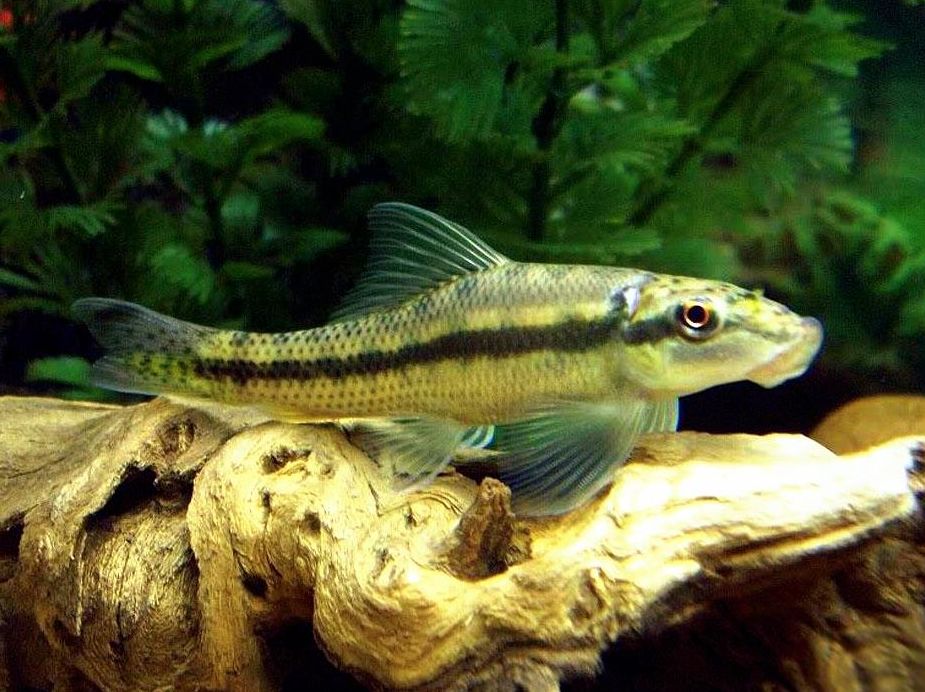
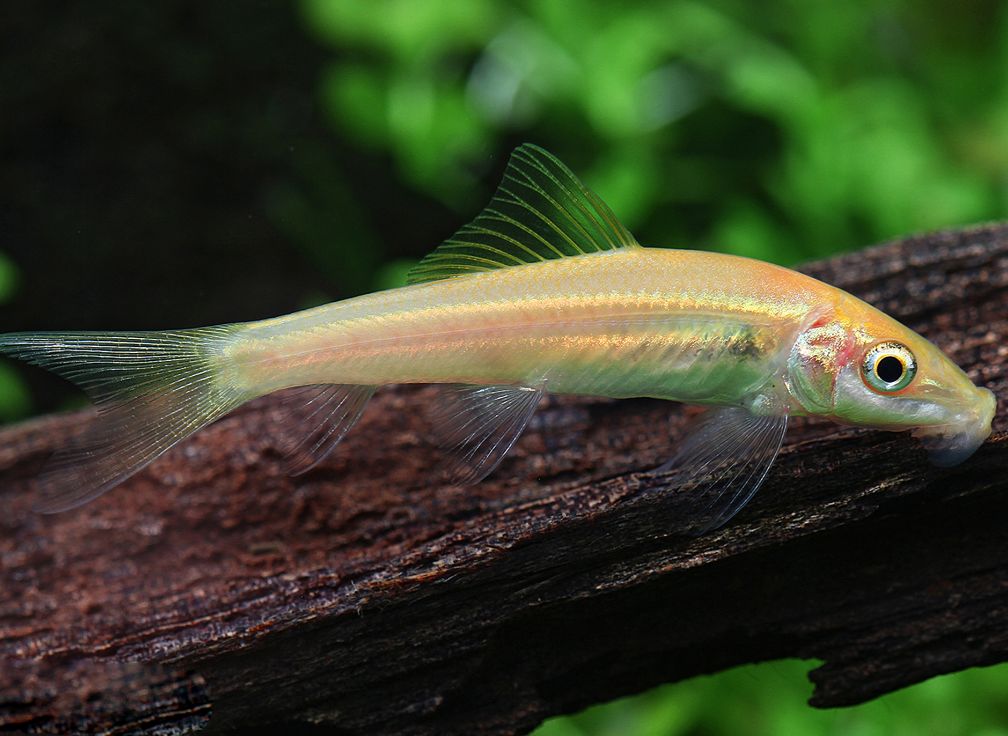
Chinese Algae Eater vs Siamese Algae Eater
Chinese Algae Eater is often confused with Siamese Algae Eater. However, these are two completely different kinds. The latter has a mouth of unusual shape and a black lateral stripe along the whole body. The Chinese algae eater can grow larger than the Siamese algae eater. Chinese algae eaters can reach up to 10 inches (25 cm) in length, while Siamese algae eaters usually reach a maximum size of around 6 inches (15 cm). Besides, they are food rivals and more peaceful and timid SAE always suffers from Chinese Algae Eater attacks.
It’s crucial to correctly identify the species when purchasing these fish, as they are sometimes mislabeled or confused with one another.
| Characteristic | Chinese Algae Eater (Gyrinocheilus aymonieri) | Siamese Algae Eater (Crossocheilus siamensis) |
|---|---|---|
| Appearance | Sleek body, dark coloration, gold stripe | Slender body, black coloration, black stripes |
| Maximum Size | Up to 10 inches (25 cm) | Around 6 inches (15 cm) |
| Aggression/Temperament | Can become aggressive and territorial | Generally peaceful and mild-tempered |
| Algae-Eating Efficiency | Decreases with age, may need supplemental food | Highly effective at consuming various algae |
| Compatibility | Aggressive towards other fish, may damage fins | More compatible with a wide range of tankmates |
| Tank Size | Requires spacious tank due to size and behavior | Suitable for moderate-sized aquariums |
| Algae Types Consumed | Consumes various types of algae | Particularly effective against black beard algae |
| Longevity | Average lifespan of 5-10 years | Average lifespan of 5-7 years |
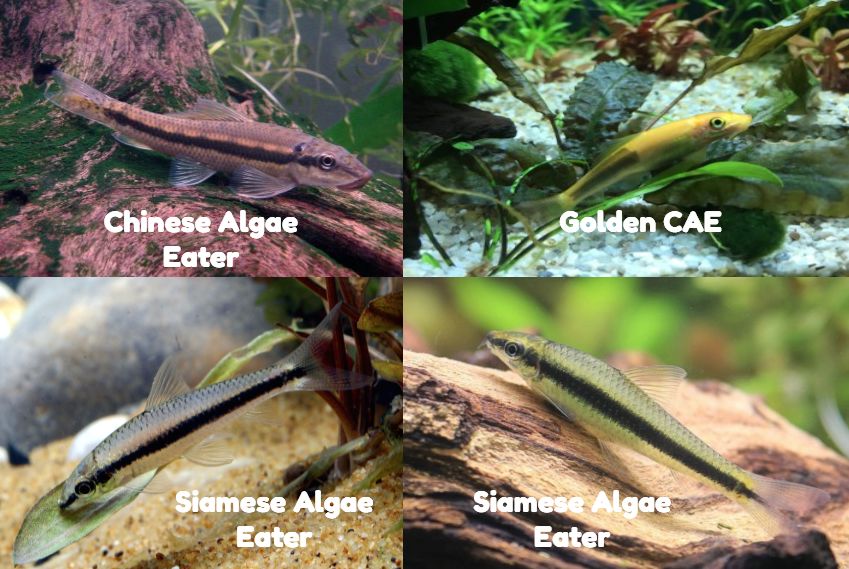
Difficulties in keeping
The chinese algae eater is good both for beginners and experienced aquarists, though there are some peculiarities. As a rule, fish is bought to deal with algae in a tank, but it grows to be quite large and doesn’t stand fishes of similar size and appearance.
Also, it likes clean water and is sensitive to nitrates content in tank water. If you don’t keep the fish with tank mates of similar genus and the tank water is clean, Chinese Algae Eater appears to be quite enduring and easily adapts to various tank water parameters.
As for perfect cleaning of tank glasses and plants from algae fouling – things are a bit different, it’s more likely that if there is no other food, the fish will clean them, but if there is something tastier it can eat, it will ask for food together with all tank dwellers. This is especially true for adult species that can completely ignore algae and compete for food with other fishes.

Care and keeping in a tank
Tank size
Chinese algae eater is an active fish that spends most of its time on the bottom. For the fish juveniles, a tank of 22 gallons (100 liters) is quite enough. For adult species, a tank of 44 gallons (200 liters) and more is required, especially if you have a group of fish in the tank. It must have a cover since they can easily jump out for the tank.
Water parameters
It is a rather strong and enduring fish that can adapt to a wide range of tank conditions. A wide range of water parameters suits the fish. Recommend water temperature is between 75-80 °F (24 – 27 °C), acidity – pH 5.8-8.0, dGH = 3-12. It prefers tank water reach with oxygen and strong water circulation.
Tank setup: decorations and plants
Chinese algae eater will feel fine in any tank if it has several shelters. Large stones, ceramic shelters, snags, and caverns will do as tank decorations. They will be especially appropriate if the fish lives together with its kind. Many shelters in a tank will help to minimize conflicts and fights.
It’s better to use medium or large-sized roundstones as a bottom substrate. It will be more convenient to scrap algae from them. Bright lighting will ensure algae growth on plants and decorations, where the fish will constantly feed. In such an environment, it will demonstrate more natural behavior, and it can be kept together with many other active and spry fishes.
The tank should be thickly planted, and the fish almost don’t damage them. These can be any plant kinds. If the fish has enough plant food, it won’t be interested in eating tank plants, even those with tiny leaves. There should be as many plants as possible, and they use them as natural shelters.
Filtration
Since the fish is mostly mountain rivers dweller, it likes very clean water, rich in oxygen, and thus in a tank, it will require a powerful canister filter. It is also desirable to create some water flow. Once a week 30% of tank water should be renewed together with bottom siphonage.
Diet
In the wild chinese algae eater feeds not only with algae and fouling on stones and plants but with small maggots as well. That’s why to keep the fish in good shape, and you should feed it with some live or frozen food from time to time. Food such as bloodworm, daphnia, and brine shrimp will do as well as high-quality dry flakes and pellets. Offer blanched vegetables like zucchini, cucumber, or spinach. These should be softened and anchored to prevent them from floating around the tank.
Quality dry food in the shape of pallets will be the best for golden algae eater. They quickly get to the tank bottom and maintain their shape for a long time, ensuring that they’ll easily scrape slowly softening food. It contains high-quality fish components, mussels, and of course, spirulina. Sinking algae wafers or pellets formulated specifically for herbivorous fish can be provided as a staple diet.
Keep in mind that if the fish is not hungry or overfed, it may stop eating algae and thus cleaning the tank. Except for common live food and flakes, you can feed the fish with spinach, lettuce, and cabbage leaves after pouring boiling water on them. Young species are peaceful and excellently clean algae in a tank. Adult species are less hardworking in this respect and may show some aggression.
You should feed them every day, but don’t forget if they are not hungry after eating dry food, they will eat green algae less eagerly. Thus if you see a splash of inferior plants in the tank, it’s better to make the fish starve a bit.
Tank mates
How many chinese algae eaters per tank?
You can keep them both alone and in groups. However, the latter is true only for young species. Large species become territory-depended and can stand neither their relatives nor any other similar tank dwellers around. It’s generally recommended to keep them as solitary fish or in small group to minimize aggression issues. Keeping a group of fishes is one way to decrease interspecific aggression. Still, you should get at least 3-5 species and more since they have hierarchic relations, and in the case of a smaller group, the fish may start pinching weaker species.
Keeping a single Chinese algae eater is also a common practice. In a tank, especially a small-sized one, only one fish can be kept; keeping a couple or a group of fish in such conditions will inevitably lead to the death of the weakest species.
Do chinese algae eaters eat other fish?
While Chinese algae eaters are primarily herbivorous and feed on algae and detritus, they can become aggressive towards other fish, especially as they mature. They have been known to exhibit territorial behavior and may harass or damage slow-swimming or bottom-dwelling tankmates. It happens often. As a rule, Chinese Algae Eater show aggression towards their kind and species with similar size, appearance, and lifestyle – for example, SAE.
This genus is also not recommended as a tank mate for large slow fishes (goldfish, discus, angelfish, Altum angelfish). Chinese algae eater may damage their integument by sucking on it and scraping off the slime covering fish body sides. Chinese algae eater are welcome in community tanks provided with active average-sized tank mates.
Here are some popular tank mates that can be suitable companions for cherry barbs:
- Harlequin Rasboras (Trigonostigma heteromorpha)
- Neon Tetras (Paracheirodon innesi)
- Ember Tetras (Hyphessobrycon amandae)
- Glowlight Tetras (Hemigrammus erythrozonus)
- Black Neon Tetras (Hyphessobrycon herbertaxelrodi)
- Cardinal Tetras (Paracheirodon axelrodi)
- Rummy Nose Tetras (Hemigrammus rhodostomus)
- Dwarf Gouramis (Trichogaster lalius or Trichogaster chuna)
- Sparkling Gouramis (Trichopsis pumila)
- Celestial Pearl Danios (Danio margaritatus)
- White Cloud Mountain Minnows (Tanichthys albonubes)
- Dwarf Rasboras (Boraras spp.)
- Endler’s Livebearers (Poecilia wingei)
- Guppies (Poecilia reticulata)
- Platies (Xiphophorus spp.)
- Corydoras Catfish (Corydoras spp. – pygmy cory, panda cory, adolfoi catfish)
- Otocinclus Catfish (Otocinclus spp.)
- Bristlenose Plecos (Ancistrus spp.)
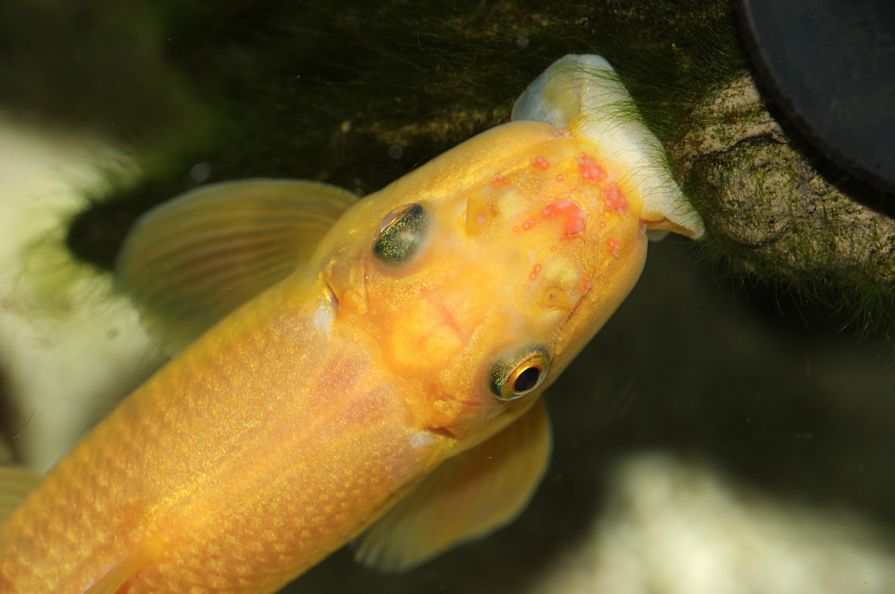
Gender differences: male vs female
Both males and females generally look alike, making it difficult to visually determine their gender. It is hard to define gender, though adult females are fatter than males and look more rounded. In most cases, determining the sex of Chinese algae eaters is not necessary for their care and maintenance in the aquarium.
Breeding
Chinese algae eater breeding in home aquariums is quite complicated. Since 1955 young fish species were imported into Europe in large numbers. This testifies that chinese algae eater is a rather infertile fish. Nowadays, it is bred in fish hatcheries using hormonal agents.
This basically makes breeding them at home challenging – hormonal injections are required. To be able to deal with this, an aquarist has to possess proper knowledge and experience.
Chinese algae eater becomes reproductive at the age of 2 years old. For breeding them, you’ll need a separate tank of about 200 liters capacity, good filtration, and strong water flow. A net is put on the bottom, and you can put some wide-leaved plants in its corners. The light should be dim. The water parameters are the following: T=24°C, pH=6.0-8.8, GH not more than 5. You must renew 10% of tank water daily.
You make two hormonal injections to the selected female with eggs. The first is made before spawning and the second one – when putting it in the tank. You also should put two males there.
One female fish can lay up to 3 thousand eggs that males then fertilize. After they lay eggs, you should remove the breeders from the tank. The eggs require constant thorough care. It includes daily small water renews and removing dead eggs. You can add some antifungal agents into the water to preserve more embryos.
Incubation lasts for about a day. The juveniles grow fast and don’t demonstrate cannibalism towards their relatives.